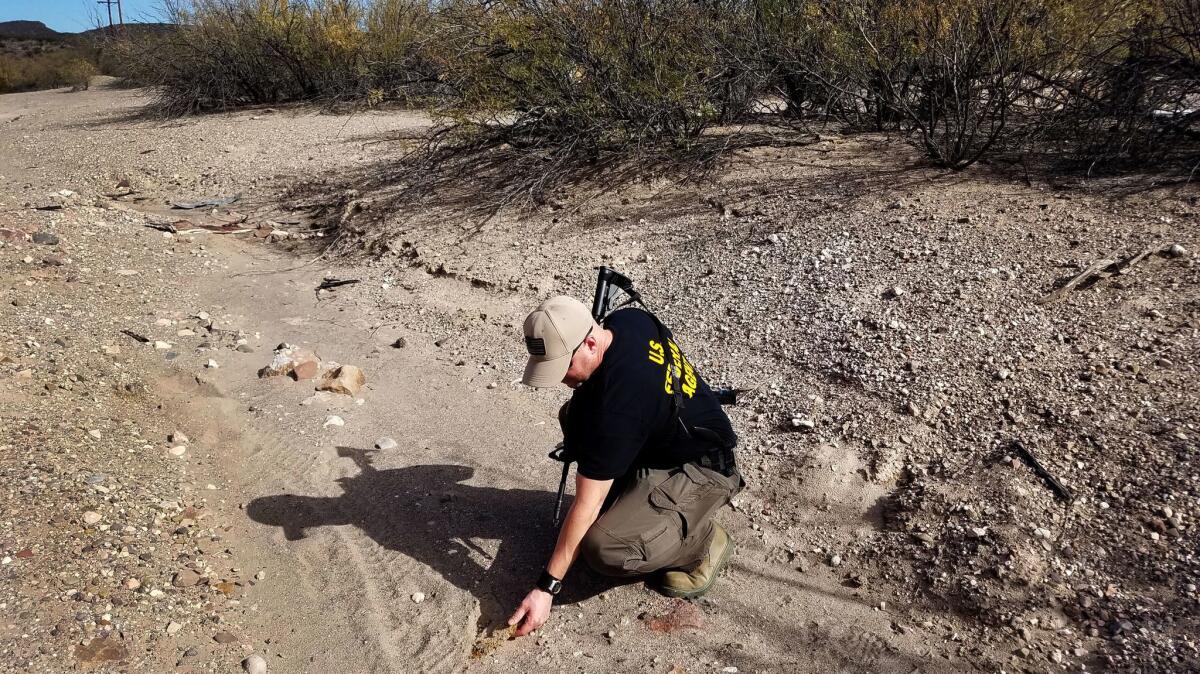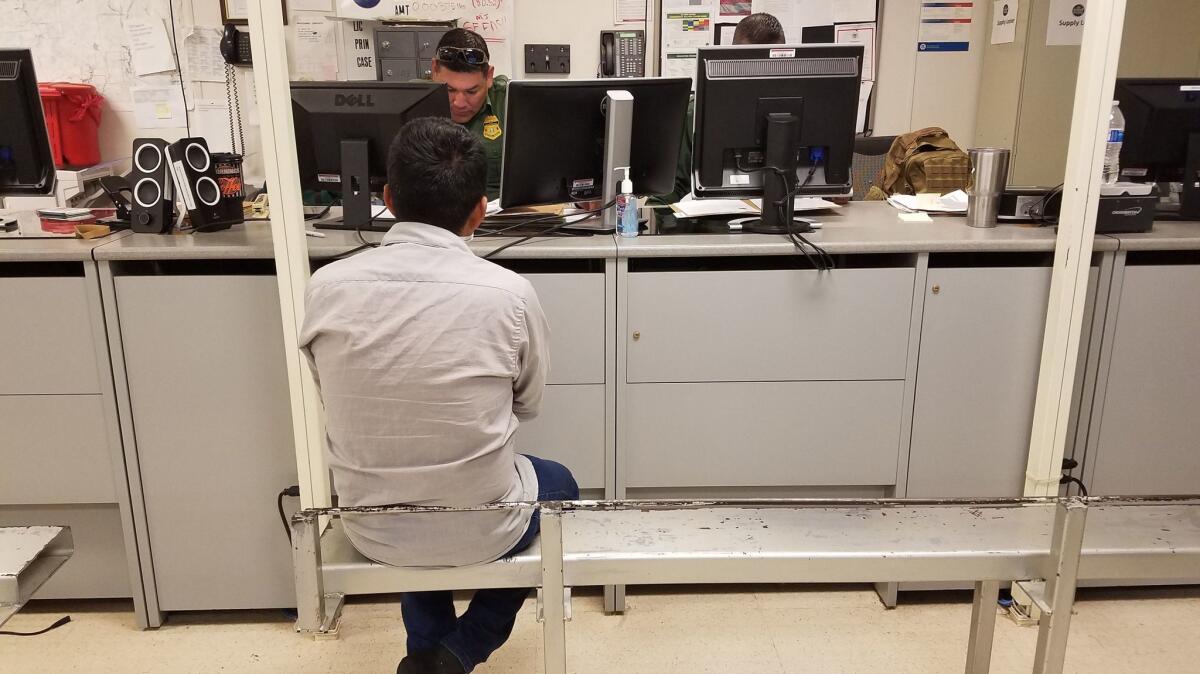Could Texas’ Big Bend be the border’s weakest link? Smuggling of drugs and immigrants is on the rise

Border Patrol agents in Texas’ Big Bend region have seen an increase in smuggling, attacks on agents and migrant deaths in recent years.
- Share via
Reporting from Porvenir, Texas — Two Border Patrol agents bent to study the sandy dirt like animal trackers — what they call “cutting for sign.”
They didn’t have to look far.
Just yards from the Rio Grande, Agent Lee Smith pointed to footprints and scraps of carpet. Smugglers tie carpet to their shoes in hopes of covering their tracks, he said. Smith followed the rough trail through thick brush, his fellow agent close behind, wearing a bulletproof vest and carrying a long gun.
They saw no one. But the agents sensed smugglers watching, waiting.
“They come right across. What’s here to stop them?” Smith said.
In the late 1990s, border traffic moved from Southern California to remote desert stretches of Arizona; by 2013, it moved east again to Texas’ Rio Grande Valley, the epicenter of migration and enforcement ever since. Now, one of the things driving the Trump administration’s push for millions of dollars in new border security measures is a troubling new reality: New smuggling routes are opening up, and some of them are even further west, in Texas’ Big Bend region.
The river here, about 60 miles east of El Paso, is just a few yards wide, one of the reasons Border Patrol agents in Big Bend have seen worrying increases in smuggling, attacks on agents and immigrant deaths.
“There’s hundreds of these crossings just in our area of operation,” Smith said. “The drug cartels, they own this part of the land. We have conceded large swaths of the border. There are areas where there are not agents for days.”
The vast Big Bend, he said, is “the absolute weakest link on the southern border.”
::
This has always been formidable country. The Chihuahuan high desert is full of prickly cat claw and temperatures that soar above 100 degrees on summer days and dip below freezing on winter nights. Rising above the desert are the snow-covered Chinati, Chisos and Davis ranges.
But the landscape that created a stunning backdrop for movies like “No Country for Old Men,” “There Will Be Blood” and “Giant” is no longer acting as a deterrent to border crossers.
Last month, agents’ worst fears were realized.
En español: ¿Podría el Big Bend en Texas ser el eslabón más débil de la frontera? »
Two Border Patrol agents were injured while investigating smugglers who had reached a culvert under Interstate 10, about 55 miles north of Porvenir. Both suffered serious head injuries. Agent Rogelio Martinez died. Agent Stephen Garland is still recovering and has trouble remembering what happened, investigators say.
The FBI is still investigating the incident and officials have offered up to $70,000 for information leading to a resolution of the case.
Just as immigrants once tried to cross the Arizona desert unprepared, Central Americans are arriving in Big Bend without cold weather gear, abandoned to the elements by smugglers. Immigrants tell agents that smugglers advertise the area as an easy crossing, the least patrolled stretch of border.

U.S. Customs and Border Protection divides the southern border into nine sectors. Big Bend is the largest: 135,000 square miles, 510 miles of river, a quarter of the entire southern border.
The sector stretches north to include 118 counties in Texas and all of Oklahoma. Yet it has the smallest staff of any southern border sector, about 500 agents assigned to a dozen stations and several highway checkpoints including one in Sierra Blanca, notorious for large drug busts. That’s fewer agents than have been assigned to a single station in the Tucson sector, Smith said.
President Trump has promised to add 5,000 Border Patrol agents, potentially doubling Big Bend staffing, but with high turnover, agents said that they would still be spread thin.
With such a small staff, agents usually patrol alone, with hand-me-down technology from other areas, including radios so spotty agents have erected makeshift cell towers in the brush to boost reception. Sometimes they just yell.
They don’t have observation towers along the border as in the Rio Grande Valley, and their single aerostat blimp hovering overhead, unlike those used in the Valley, is not equipped with infrared technology, Smith said.
“You know what it helps?” Smith said. “Migrants. They use it as a guide: Go that direction.”
The only time they received drones, agents complained, was when the devices were sent west from southeast Texas for safekeeping before Hurricane Harvey hit in August.
Since the summer, Big Bend saw the biggest increase in unaccompanied youth caught on the border, mostly Central Americans: 278 since the federal fiscal year that began in October, up 74% from last year. By contrast, the number of youths caught in the Rio Grande area dropped 64% during the same period.

At the same time, Big Bend saw drug seizures drop, Smith and other agents said. That’s because smugglers use the immigrants as decoys, they said, and abandon dozens at a time to overwhelm agents, before sending drug mules with 50-pound backpacks of marijuana in their wake.
Big Bend agents caught 6,000 people last fiscal year, which ended in September. During the next two months, they caught 1,646 people, putting them on pace to far exceed last year’s total.
Big Bend agents seized 40,852 pounds of marijuana last fiscal year, but 4,211 pounds in the first two months of this year. That’s more than a thousand pounds less per month.
As conditions deteriorated, some agents said they feared a death was inevitable, even though an agent hadn’t died on the job since 1929, when one was killed by bandits smuggling liquor during Prohibition.
FBI officials are still investigating the incident involving the two Border Patrol agents that appears to have occurred shortly after 11 p.m. on Nov. 18. The two men had been looking into some unspecified “activity” near a culvert and were found later with head injuries and broken bones.
Border Patrol agents continue to patrol the area, but so far have found no conclusive clues.
Walking the 9-foot-deep concrete culvert where Martinez, 36, was found fatally injured, Smith pointed out signs of recent smuggling: A gray backpack, a man’s black-and-white checked shirt, an empty water jug in a holder sewn from a pair of blue jeans.
Up on the highway, traffic zoomed past a lighted sign advertising “Reward for information Border Patrol agent death.”
Days after the agents were injured, another was sent to investigate potential smuggler activity in a culvert farther south, alone. The agent, who asked not to be named because he was not authorized to speak, didn’t encounter anyone, but he was nervous: His two backup agents at a nearby station has been sent north to help after the attack.
“If it picks up here, we’re just going to be unprepared,” Smith said.
He and other agents said they need more staff, improved radios, cameras and other equipment. Otherwise, they worry they may become overwhelmed the way Rio Grande Valley agents were by tens of thousands of Central American youth and families in 2014.
They also worry for the immigrants unprepared for the harsh conditions of Big Bend. This month, agents patrolling by air spotted 15 Guatemalan men lost in the desert. The agents caught and brought them to a station, but the immigrants were already suffering hypothermia. One died. Immigrant families often turn themselves in, Smith said, but agents are increasingly discovering skeletons in the desert.
Recently a group of 50 immigrants — mostly Guatemalan families and a couple of Hondurans — turned themselves in at Presidio, about 250 miles east of El Paso. Across from the bustling Mexican town of Ojinaga, connected by an official bridge and makeshift river crossings marked by guide wires, Presidio has become a hot spot for families who claim asylum, agents said.
On the Mexican side stands a roughly 50-foot-high retention wall topped with razor wire, set back from the river, built after a flood in 2008. Agents said it may be time to build a similar wall on the U.S. side.
A day after the Central American group arrived, half a dozen agents were still processing them in the Presidio station, a collection of trailers with reward posters on the door for Martinez. One by one, the immigrants turned over their belongings — shoes, backpacks, toys — in exchange for numbered tags they would later use to reclaim them.
Four women huddled with three children on pallets on the concrete floor. Agents would like to expand and improve the holding area, eventually moving to a permanent building.
“That’s on our wish list,” said Border Patrol Agent Rush Carter, a spokesman for the agency in Big Bend.
Instead, they lined up a dozen of the immigrants, including a young mother clutching a baby, outside where Border Patrol vans waited to take them to two other Big Bend stations. Agents there would have to interrupt other duties to help process the latest arrivals.
molly.hennessy.fiske@latimes.com
Twitter: @mollyhf
More to Read
Sign up for Essential California
The most important California stories and recommendations in your inbox every morning.
You may occasionally receive promotional content from the Los Angeles Times.














